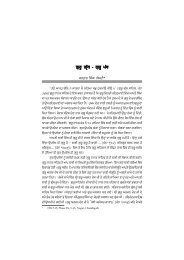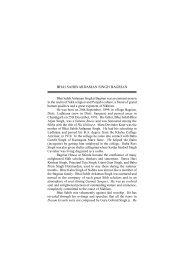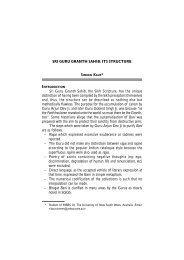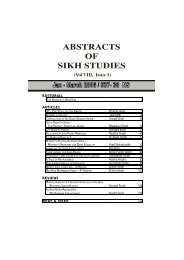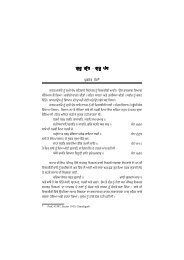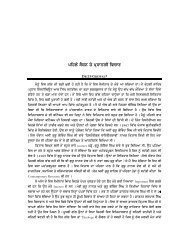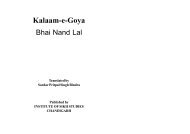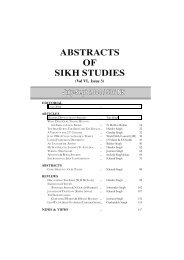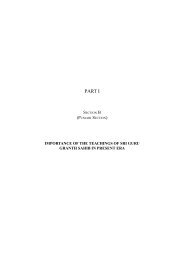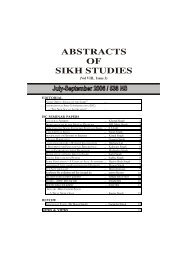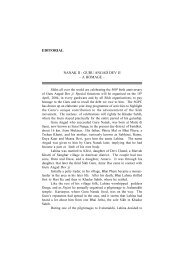editorial articles reviews news & views - Institute of Sikh Studies
editorial articles reviews news & views - Institute of Sikh Studies
editorial articles reviews news & views - Institute of Sikh Studies
Create successful ePaper yourself
Turn your PDF publications into a flip-book with our unique Google optimized e-Paper software.
MCLEOD & FENECH AS SCHOLARS ON SIKHISM AND MARTYRDOM<br />
83<br />
do institute a different history .<br />
Without bringing in Guru Gobind Singh’s 24 years <strong>of</strong> life, 1675-<br />
1698, the author straightway brings in the manifestation <strong>of</strong> Khalsa in<br />
1699. He does not mention that Sehajdhari <strong>Sikh</strong>s did exist at that time.<br />
The author follows the Singh Sabha rendering <strong>of</strong> the <strong>Sikh</strong> history. He<br />
is not sure about the ‘death’ <strong>of</strong> Guru Gobind Singh at the hands <strong>of</strong><br />
the Pathan assassin.<br />
Fenech contradicts himself grievously when he attributes to<br />
‘tradition’; one does not know from where, Guru Gobind Singh’s<br />
finding ‘feeble hearted’ <strong>Sikh</strong>s, who read only Adi Granth. That probably<br />
gives the origin <strong>of</strong> Dasam Granth. But the composition compiled by<br />
Bhai Mani Singh does not get that title. Fenech also brings up the<br />
compositions about the battle <strong>of</strong> Bhangani and other battles entered<br />
by Guru Gobind Singh during the decade 1689-99, with Hindu hill<br />
rajas, but he fights shy <strong>of</strong> the word ‘Hindu’ for obvious reasons. Though<br />
Guru Gobind Singh does write Zafarnama to Aurangzeb, ‘tradition’<br />
tells Fenech that it “was apparently written” for the Mughal Emperor.<br />
Fenech obviously makes a fool <strong>of</strong> himself when he realises that<br />
‘tradition’ may here be close to history when he talks <strong>of</strong> dharm-yudh. It<br />
was at this dharm-yudh that the battle <strong>of</strong> Chamkaur was fought and<br />
Guru Gobind Singh, in the very first Gurmatta was asked to make<br />
good his escape. In the post Guru Gobind Singh era, Fenech mentions<br />
Banda Bahadur apart from Baz Singh, Bhai Tara Singh, Bota Singh,<br />
Garja Singh, Mehtab Singh, Sewa Singh, Gurbakhsh Singh and Baba<br />
Ram Singh Bedi – all in one paragraph. It is a Persian Chronicler, a<br />
Muslim who gives first information about a young <strong>Sikh</strong> boy who<br />
disowned his mother to kiss the scaffold.<br />
Then in the next paragraph follow Bhai Mani Singh, Taru Singh,<br />
Subeg Singh and Shahbaz Singh, the young boys, going upto Gurdwara<br />
reforms movement He mentions <strong>Sikh</strong> prayer <strong>of</strong> thanks at Vada<br />
Ghallughara, big holocaust.<br />
Fenech, now comes to the end <strong>of</strong> this chapter with a narration <strong>of</strong><br />
“enormously popular” Baba “Dip Singh.” In 1757, he vowed to fight<br />
Jahandar Khan to Amritsar. At Tarn Taran, the fight was fierce and<br />
though he quotes Khushwant Singh’s A History <strong>of</strong> the <strong>Sikh</strong>s to say that



